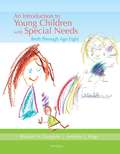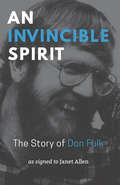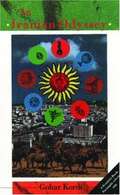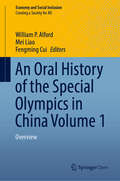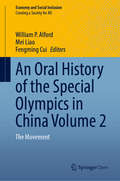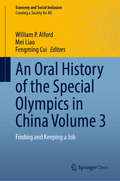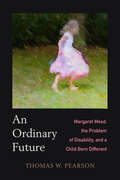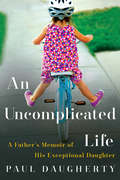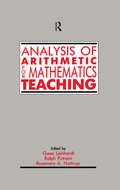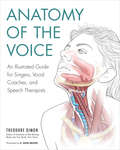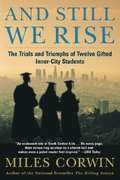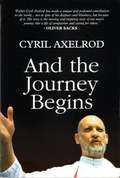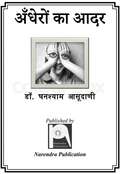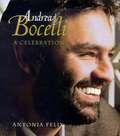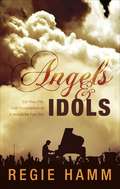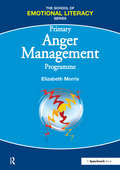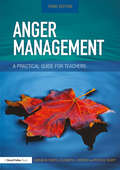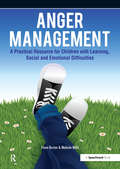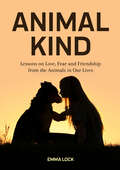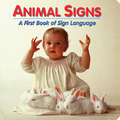- Table View
- List View
An Introduction to Young Children with Special Needs Birth Through Age Eight
by Richard M. Gargiulo Jennifer L. KilgoAN INTRODUCTION TO YOUNG CHILDREN WITH SPECIAL NEEDS offers a thorough introduction to the educational policies, programs, practices, and services specific to infants, toddlers, and preschoolers who demonstrate delays and disabilities. It also offers information about youngsters who exhibit signs of being at-risk for future programs in learning and development. Through a host of proven learning techniques, a website, and additional related resources, readers are guided to a full understanding of important theoretical and philosophical foundations in serving children whose learning is delayed. These include authentic assessments, cultural sensitivity and competence, activity-based interventions, and developmentally and individually appropriate practices. The book emphasizes instructional strategies necessary for creating inclusive learning environments, and offers recommendations throughout for using technology in the learning environment.
An Invincible Spirit: The Story of Don Fulk
by Janet Allen“Don taught us how to be a real independent living center. Nothing was easy; every issue that came up on the road to Don’s independence was a challenge and a struggle, but the experience pushed us and we learned from it. We were not going to let Don down; all of us were committed to Don’s freedom and independence.” —Kathleen Kleinman, Executive Director, TRPIL (Transitional Paths to Independent Living) Profoundly deafened as an infant, Don Fulk didn’t learn his name or go to school until the age of ten. When he was eighteen years old and a budding superstar on his football and basketball teams, he broke his neck in a swimming accident, and became paralyzed. After his injury, he was confined to a bed in his parents’ home for eight years, unable to move and barely able to communicate. After his family could no longer care for him, he spent nine years in a nursing home where he suffered from abuse and neglect. Yet through a life marred by isolation and frustration, Fulk endured with strength, humor, and grace. He never gave up pursuing his dreams for independence and self-worth, and improving the lives of others. He fought a system that was unfair and discriminatory, and helped pave the way for people with disabilities to live independently. Don Fulk signed his story to author Janet Allen, describing his difficult home life, the incredible friends who changed his life, and his dramatic escape from an abusive nursing home. An Invincible Spirit is a story of hope, empowerment, and the battles people with disabilities have fought—and continue to fight—to improve the quality of their lives.
An Invincible Spirit: The Story of Don Fulk
by Janet Allen“Don taught us how to be a real independent living center. Nothing was easy; every issue that came up on the road to Don’s independence was a challenge and a struggle, but the experience pushed us and we learned from it. We were not going to let Don down; all of us were committed to Don’s freedom and independence.” —Kathleen Kleinman, Executive Director, TRPIL (Transitional Paths to Independent Living) Profoundly deafened as an infant, Don Fulk didn’t learn his name or go to school until the age of ten. When he was eighteen years old and a budding superstar on his football and basketball teams, he broke his neck in a swimming accident, and became paralyzed. After his injury, he was confined to a bed in his parents’ home for eight years, unable to move and barely able to communicate. After his family could no longer care for him, he spent nine years in a nursing home where he suffered from abuse and neglect. Yet through a life marred by isolation and frustration, Fulk endured with strength, humor, and grace. He never gave up pursuing his dreams for independence and self-worth, and improving the lives of others. He fought a system that was unfair and discriminatory, and helped pave the way for people with disabilities to live independently. Don Fulk signed his story to author Janet Allen, describing his difficult home life, the incredible friends who changed his life, and his dramatic escape from an abusive nursing home. An Invincible Spirit is a story of hope, empowerment, and the battles people with disabilities have fought—and continue to fight—to improve the quality of their lives.
An Iranian Odyssey
by Gohar KordiFrom the Book Jacket: Gohar Kordi was born in a small Kurdish village in Iran. At the age of four, she became blind. She writes of her growing up in the country, the family's move to Tehran and her personal struggle to get an education and become the first woman student at the university. Compelling, with a quiet, hypnotic power, An Iranian Odyssey is an autobiography that reveals its belief that adversity can be overcome.
An Oral History of the Special Olympics in China Volume 1: Overview (Economy and Social Inclusion)
by William P. Alford Mei Liao Fengming CuiThis open access book is unique in presenting the first oral history of individuals with an intellectual disability and their families in China. In this summary volume and the two accompanying volumes that follow, individuals with an intellectual disability tell their life stories, while their family members, teachers, classmates, and co-workers describe their professional, academic, and family relationships. Besides interview transcripts, each volume provides observations and records in real time the daily experiences of people with an intellectual disability. Drawing on the methodologies of sociology and oral history, the summary volume provides an unprecedented account of how people with intellectual disabilities in China understand themselves while also examining pertinent issues of public policy and civil society that have ramifications beyond the field of disability itself.
An Oral History of the Special Olympics in China Volume 2: The Movement (Economy and Social Inclusion)
by William P. Alford Mei Liao Fengming CuiThis open access book contains the oral histories that were inspired by the work of the Special Olympics in conjunction with the 50th anniversary of its founding. The foreword and prefatory materials provide an overview of the Special Olympics and its growth in the People’s Republic of China. The sections that follow record interview transcripts of individuals with intellectual disabilities living in Shanghai. In addition to chronicling the involvement of these individuals and their families in the Special Olympics movement, the interview transcripts also capture their daily lives and how they have navigated school and work.
An Oral History of the Special Olympics in China Volume 3: Finding and Keeping a Job (Economy and Social Inclusion)
by William P. Alford Mei Liao Fengming CuiThis open access book brings together oral histories that record the experiences of individuals with intellectual disabilities in Shanghai as they participate in their careers. Employees with intellectual disabilities describe their experiences seeking, attaining, and maintaining employment. Their managers, colleagues, and family members also provide keen insight into the challenges and opportunities these individuals have encountered in the process of securing employment. An appendix provides a compilation of employment policies related to people with intellectual disabilities, particularly with respect to Shanghai.
An Ordinary Future: Margaret Mead, the Problem of Disability, and a Child Born Different
by Thomas W PearsonThis vivid portrait of contemporary parenting blends memoir and cultural analysis to explore evolving ideas of disability and human difference. An Ordinary Future is a deeply moving work that weaves an account of Margaret Mead's path to disability rights activism with one anthropologist's experience as the parent of a child with Down syndrome. With this book, Thomas W. Pearson confronts the dominant ideas, disturbing contradictions, and dramatic transformations that have shaped our perspectives on disability over the last century. Pearson examines his family's story through the lens of Mead's evolving relationship to disability—a topic once so stigmatized that she advised Erik Erikson to institutionalize his son, born with Down syndrome in 1944. Over the course of her career, Mead would become an advocate for disability rights and call on anthropology to embrace a wider understanding of humanity that values diverse bodies and minds. Powerful and personal, An Ordinary Future reveals why this call is still relevant in the ongoing fight for disability justice and inclusion, while shedding light on the history of Down syndrome and how we raise children born different.
An Orientation and Mobility Primer for Families and Young Children
by Everett W. Hill Bonnie Dobson-BurkThis book describes the skills children with visual impairments need to get around safely and efficiently, and helps parents start their youngsters on the way to being independent. Chapters cover sensory training, concept development, motor development, and orientation skills, and offers suggestions on how to encourage a child to move, to identify the sources of sounds, to keep track of objects, and to play successfully with others.
An Uncommon Gift
by James S. EvansThe following quote is taken from the side flaps of the book: "Jamie Evans knows the meaning of fear, but it is not a posture he accepts himself. Like millions of Americans, he suffers from dyslexia and hyperkinesia. In this remarkable story of his struggle to combat these difficulties, he meets obstacle after obstacle and knocks them down, one by one. He reveals what is going on inside the person who cannot sit still, who is frustrated by an inability to read, who stutters, whose behavior is generally disruptive. The son of Dr. Louis H. Evans, Jr., and Colleen Townsend Evans, Jamie was born into a nurturing family who offered him love and provided excellent educational opportunities. Still, he had to fight a lonely battle. Beyond academic problems, Jamie experienced a lack of esteem and self-love. He was an angry, controlling person. In AN UNCOMMON GIFT Jamie relates how he conquered his learning disabilities. He shows that through counseling and supportive relationships deep emotional scars began to heal. From an individual who demanded constant attention emerged a caring person who recognizes the special needs of others. This is also a story of enduring faith. The author believes that God would not have given him problems without providing the resources to cope with them. He describes experiencing the power of Christ, who remained with him during a healing process that went on for years. Forthright, compelling, fascinating to read, this story of a young man's inner and outer struggles and ultimate victory carries a special message for all those who face life with handicaps to overcome, as well as for the families and friends who stand with them."
An Uncomplicated Life
by Paul DaughertyA father's exhilarating and inspiring love letter to his daughter with Down syndrome, whose vibrant and infectious approach can teach us all how to live a little better"Jillian was born October 17, 1989. It was the last bad day."Jillian Daugherty was born with Down syndrome. The day her parents, Paul and Kerry, brought her home from the hospital, they were flooded with worry and uncertainty, but also with overwhelming love, which they channeled to "the job of building the better Jillian." They knew their daughter had special needs, but they refused to have her grow up needy. They were resolved that Jillian's potential would not be limited by preconceptions of who she was or what she could be.In this charming and often heart-stirring book, Paul tells stories about Jillian making her way through the world of her backyard and neighborhood, going to school in a "normal" classroom, learning to play soccer and ride a bike. As she grows older, he traces her journey to find happiness and purpose in her adult life, including vignettes about her inspiring triumphs and the guardian angels--teachers, neighbors, friends--who believed in Jillian and helped her become the exceptional young woman she is today.In An Uncomplicated Life, the parent learns as much about life from the child as the child does from the parent. Being with Jillian, Paul discovered the importance of every moment and the power of the human spirit--how we are each put here to benefit the other. Through her unmitigated love for others, her sparkling charisma, and her boundless capacity for joy, Jillian has inspired those around her to live better and more fully. As Paul writes, "Jillian is a soul map of our best intentions," a model of grace, happiness, and infectious enthusiasm. She embraces all that she is, all that she has--"I love my life. I just love my life," she says. In her uncomplicated life, we see the possibility, the hope, and the beauty of our own.
Analysis of Arithmetic for Mathematics Teaching
by Gaea LeinhardtThis volume emerges from a partnership between the American Federation of Teachers and the Learning Research and Development Center at the University of Pittsburgh. The partnership brought together researchers and expert teachers for intensive dialogue sessions focusing on what each community knows about effective mathematical learning and instruction. The chapters deal with the research on, and conceptual analysis of, specific arithmetic topics (addition, subtraction, multiplication, division, decimals, and fractions) or with overarching themes that pervade the early curriculum and constitute the links with the more advanced topics of mathematics (intuition, number sense, and estimation). Serving as a link between the communities of cognitive researchers and mathematics educators, the book capitalizes on the recent research successes of cognitive science and reviews the literature of the math education community as well.
Anatomy of the Voice: An Illustrated Guide for Singers, Vocal Coaches, and Speech Therapists
by Theodore Dimon G. David BrownThe first comprehensive, fully-illustrated approach to the voice that explains the anatomy and mechanics in detailed yet down-to-earth terms, for voice users and professionals of all kindsThis book is the first to explain, in clear and concise language, the anatomy and mechanics of the mysterious and complex bodily system we call the voice. Beautifully illustrated with more than 100 detailed images, Anatomy of the Voice guides voice teachers and students, vocal coaches, professional singers and actors, and anyone interested in the voice through the complex landscape of breathing, larynx, throat, face, and jaw. Theodore Dimon, an internationally recognized authority on the subject, as well as an expert in the Alexander Technique, makes unfamiliar terrain accessible and digestible by describing each vocal system in short, manageable sections and explaining complex terminology. The topics he covers include ribs, diaphragm, and muscles of breathing; the intrinsic musculature of the larynx, its structure and action; the suspensory muscles of the throat; the face and jaw; the tongue and palate; and the evolution and function of the larynx.
And Show Steadfast Love: A Theological Look at Grace, Hospitality, Disabilities, and the Church
by Lewis H. MerrickA collection of essays about the church's relationships with people with disabilities.
And Still We Rise (The Trials and Triumphs of Twelve Gifted Inner-City Students)
by Miles CorwinHe was yet another victim of a drive-by shooting, a teenage boy splayed out on a South-Central Los Angeles street corner, with several gunshot wounds to the chest. He died before the paramedics arrived. The two homicide detectives could find no wallet and no identification on the boy, so the coroner's investigator called him John Doe Number 27. Bestselling author of The Killing Season and veteran Los Angeles Times reporter Miles Corwin spent a school year with twelve high school seniors -- South-Central kids who qualified for a gifted program because of their exceptional IQs and test scores. Sitting alongside them in classrooms where bullets were known to rip through windows, Corwin chronicled their amazing odyssey as they faced the greatest challenges of their academic lives. And Still We Rise is an unforgettable story of transcending obstacles that would dash the hopes of any but the most exceptional spirits.
And The Journey Begins
by Cyril Axelrod<P>This life story of deafblind priest, Father Cyril Axelrod, makes compelling reading. A man of such spirituality, humanity, gentleness, compassion, humour, leadership and vision, he has worked tirelessly for others throughout his life and has become a worldwide ambassador for deaf and deafblind people. <P>He gives a remarkably poignant and tender account of his childhood as the profoundly Deaf child of an orthodox Jewish family in South Africa. He describes the wrenching spiritual journey that follows in his twenties and led him eventually to become a Catholic priest in order to serve deaf people. He tells too of his own painful transition from deafness to deafblindess as his sight deteriorates in middle age as a result of Usher syndrome. <P>Despite this, his remarkable pastoral work continues, using over eight different indigenous sign languages, in countries as varied as South Africa, Mozambique, Zimbabwe, Australia, USA, China, Singapore, Macau, Ireland, and finally Britain. His work and his love for deaf and deafblind people transcends colour, creed and faith and has been recognised throughout the world. <P>This is the story of a remarkable man.
Andheron Ka Aadhar: अंधेरों का आधार
by Dr Ghanshyam Asudani"अंधेरों का आधार" 15 हिंदी लघु कथाओं का संग्रह है। पुस्तक "विकलांगता प्रवचन" की उभरती हुई साहित्यिक शैली की आकाशगंगा में नवीनतम सितारा है। कहानियां पारिवारिक जीवन, प्रेम संबंध, रोजगार, समाज द्वारा उपेक्षा, आर्थिक समस्याओं आदि सहित जीवन के विभिन्न पहलुओं पर दृष्टिबाधित जीवन का गहराई से विश्लेषण करती हैं। लेखक ने वर्तमान परिदृश्य में दृष्टिबाधित व्यक्ति के जीवन का एक व्यापक चित्र प्रस्तुत किया है। उच्च साहित्यिक मूल्य होने के साथ-साथ यह पुस्तक "विकलांगता प्रवचन" शोध के लिए एक बहुत ही महत्वपूर्ण और उपयोगी संसाधन है।
Andrea Bocelli: A Celebration
by Antonia FelixThe author presents text and pictures from Andrea Bocelli's life. Information concerning how different conductors worked with Andrea as he made his entrance in the opera are included.
Angel Unaware
by Dale Evans RogersRobin Rogers tells the story of her two years on earth, and how she helped her parents, Roy Rogers and Dale Evans Rogers, toward a firm faith.
Angels and Idols: The Rise, Fall, and Redemption of a Would-be Pop Star
by Regie HammRegie Hamm's life has all the twists, turns, and drama of a Hollywood movie. Only this isn't Hollywood, and the cast isn't actors. As a hit artist, producer, and songwriter, Regie was familiar with the drama of the press, the endless nights in the studio, and the uncertainty of his next paycheck. But nothing would prepare him for the drama of a rural Chinese hospital, the endless nights of raising an insomniac baby, or the uncertainty of her condition. There was nothing he could do except stand by and helplessly watch his life and career spin out of control. Regie's story is one of a man and his family who overcame enormous obstacles. It is a journey that put him in the company of Angels and Idols--a journey that would test not only his physical resources but also his faith. Join author Regie Hamm as he recounts his rise, his fall, and his ultimate surrender to God's will.
Anger Management Programme - Primary: Complete Programme (Emotional Literacy Approach S. Ser.)
by Elizabeth MorrisThis is a series of lesson plans to use with a class or group to help them sense, understand and appropriately express their various levels of anger. It is suitable for ages: 4-11, and teachers.
Anger Management: A Practical Guide for Teachers
by Elizabeth Herrick Adrian Faupel Peter M. SharpDo you work with angry children? Are you wondering why young people don’t listen when they are angry? Are you exhausted from trying to understand angry behaviour? Are you having difficulty finding specialist help as soon as you need it? Anger Management is a practical guide that will help you to stay calm in the face of angry outbursts from children and young people, and support them in learning to manage their anger better. Written by chartered psychologists with extensive experience in the field, this helpful book will: increase your understanding of anger; offer you a range of practical management interventions; help you to manage your own behaviours to build more effective relationships; reduce the stress experienced by staff and parents who lack confidence in the face of aggressive behaviour. With stress and anger levels amongst young people at an all-time high, this third edition of Anger Management is particularly timely. It reflects significant developments in the fields of neuropsychology and our understanding of the physiology of emotions, as well as updated research into attachment theory, resilience, Acceptance and Commitment therapy and positive psychology. New sections include the importance of teaching forgiveness, gratitude and compassion, Mindfulness, the benefits of exercise, practical advice for Teaching Assistants and a ‘how to’ guide to managing risk. The book also discusses the revised Code of Practice for children and young people with Special Educational Needs and Disabilites (SEND 2014) and explores the implications of these changes for practitioners. Containing helpful worksheets, examples, explanations and practical advice, Anger Management provides targeted support for anyone working directly with children and young people to enable you to cope with angry behaviour in the best way possible, which is crucial for the wellbeing of adult and child alike. This book will prove invaluable to teachers as well as parents, teaching assistants, carers, psychologists, social workers and health care workers.
Anger Management: A Practical Resource for Children with Learning, Social and Emotional Difficulties
by Melanie Wells Fiona BurtonMany children with language and learning difficulties also experience difficulties with social, emotional and behavioural development. Emotional literacy packages often contain worksheets, stories and abstract language concepts. Children who have difficulties with literacy, attention or speech and language may find it difficult to access many aspects of these packages. This resource aims to deliver an appealing, practical and meaningful programme which all children (including those with learning difficulties) will find easy to access and enjoy. There are eight sessions which cover: Understanding anger; Understanding feelings; Self-esteem; Triggers and fuses; Learning to think differently; Physiology and relaxation; Strategies to manage anger; and, Review and reinforce. The accompanying downloadable resources provide colour images and practical worksheets from the resource session material that can easily be printed. This is a comprehensive, practical resource that facilitates the development of children's belief in their own ability to change and equips them with the skills to achieve change.
Animal Kind: Lessons on Love, Fear and Friendship from the Animals in Our Lives
by Emma LockTrue stories of therapy, companionship, recovery, and other good things animals bring to our lives—plus photos and facts on a variety of species.In Animal Kind, popular YouTuber Emma Lock of YouTube fame shares stories of the incredible ways that animals keep us healthy and happy, physically and mentally. You’ll be inspired by tales of remarkable recovery, from vision-impaired individuals who have gained independence with the help of seeing-eye dogs, to the woman who found new life as an equestrian champion after an arm amputation.The stories in Animal Kind feature an array of relationships that may surprise you. Even wild animals like snakes and raccoons have been known to offer life-changing companionship. With each story, you’ll learn fun facts about the featured species and hear from the people who love them. You’ll also hear the never-before-told story of how animals changed Emma’s own life for good.
Animal Signs: Animal Signs
by Debbie SlierCharming, full-color photographs of basic animals plus illustrations of their corresponding signs offer children ages 1 to 4 a fun way to learn their first signs and vocabulary words. Constructed of sturdy cardboard with a protective finish on each page, this hearty book will withstand the hard use to which fascinated young children will subject it, reading it again and again. Studies have shown that babies who learn to sign can communicate at an earlier age than those who learn verbal communication alone. Other research indicates that children strengthen their grammar and vocabulary skills by learning sign language. Animal Signs and its companion book, Word Signs, offer children exciting new worlds describing favorite things and animals while also making learning language skills fun!
